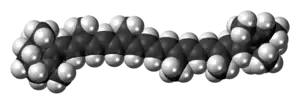α-Carotene
α-Carotene (alpha-carotene) is a form of carotene with a β-ionone ring at one end and an α-ionone ring at the opposite end. It is the second most common form of carotene.
 | |
 | |
| Names | |
|---|---|
| IUPAC name
(6′R)-β,ε-Carotene | |
| Systematic IUPAC name
1,3,3-Trimethyl-2-{(1E,3E,5E,7E,9E,11E,13E,15E,17E)-3,7,12,16-tetramethyl-18-[(1R)-2,6,6-trimethylcyclohex-2-en-1-yl]octadeca-1,3,5,7,9,11,13,15,17-nonaen-1-yl}cyclohex-1-ene | |
| Identifiers | |
3D model (JSmol) |
|
| ChEBI | |
| ChemSpider | |
PubChem CID |
|
| UNII | |
CompTox Dashboard (EPA) |
|
| |
| |
| Properties | |
| C40H56 | |
| Molar mass | 536.873 |
Except where otherwise noted, data are given for materials in their standard state (at 25 °C [77 °F], 100 kPa).
Infobox references | |
Human physiology
In American and Chinese adults, the mean concentration of serum α-carotene was 4.71 μg/dL. Including 4.22 μg/dL among men and 5.31 μg/dL among women.[1][2]
Dietary sources
The following vegetables are rich in alpha-carotene:[1]
- Yellow-orange vegetables: Carrots (the main source for U.S. adults), sweet potatoes, pumpkin, winter squash
- Dark-green vegetables: Broccoli, green beans, green peas, spinach, turnip greens, collards, leaf lettuce, avocado
References
- Li C, Ford ES, Zhao G, Balluz LS, Giles WH, Liu S (March 2011). "Serum α-carotene concentrations and risk of death among US Adults: the Third National Health and Nutrition Examination Survey Follow-up Study". Arch. Intern. Med. 171 (6): 507–15. doi:10.1001/archinternmed.2010.440. PMID 21098341. Archived from the original on 29 November 2010.
- Christian Nordqvist (22 November 2010). "Those With High Alpha-Carotene Blood Levels Live Much Longer". Medical News Today.
- Alpha-carotene Linked to Lower Mortality Rates Archived 2012-05-13 at the Wayback Machine, Tufts Health and Nutrition Letter, March 2011
This article is issued from Wikipedia. The text is licensed under Creative Commons - Attribution - Sharealike. Additional terms may apply for the media files.